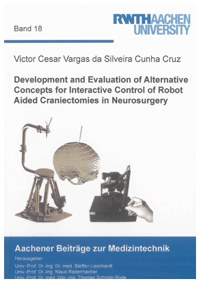
Shop : Details
Shop
Details

August 2013
Victor Cesar Vargas da Silveira Cunha Cruz
Development and Evaluation of Alternative Concepts for Interactive Control of Robot Aided Craniectomies in Neurosurgery
In the framework of Neurosurgery craniectomy is a surgical procedure required due to diverse pathological processes. This procedure is usually performed manually by a surgeon using a milling device. As this procedure removes completely cranial bone, it has to be replaced by an implant. In order to achieve safety, efficiency of the process and accuracy for implant placement, such procedure requires good expertise and coordination of the surgeon. With the development of computer-assisted surgery and robotics, the application of such procedures took place also for craniectomy. These implementations are mainly intended to increase safety, accuracy and for optimization of the milling process. However the surgeon still has to be aware and perceive the status of the procedure to react or intervene in non-planned situations. The use of interface devices in terms of synergistic and haptic architectures is intended to re-integrate the surgeon to the control procedure, while preserving advantages of automatic parameter control.
This work presents the investigation of the use of haptic technology in a neurosurgery robotic system for craniectomy, regarding aspects such as awareness, vigilance, workload, and safety as well as requirements of the milling process. A combination of haptic device and autonomous robot is proposed. For comparisons and evaluation of different operation modes (autonomous and synergistic as well as haptic master-slave interaction) experimental studies have been conducted using laboratory setups with different user groups, including computer based simulations.
Results showed the potential of haptic technology in order to increase surgeons integration in the control of robotic system. Haptic feedback based control presented results similar to the autonomous implementation. Safety can be potentially increased due to faster surgeon reactions during the process, while milling process parameters could be controlled automatically. On the other hand, special care must be taken due to the increase of workload, however the haptic display solution showed lower increases compared to the synergistic mode.
This work presents the investigation of the use of haptic technology in a neurosurgery robotic system for craniectomy, regarding aspects such as awareness, vigilance, workload, and safety as well as requirements of the milling process. A combination of haptic device and autonomous robot is proposed. For comparisons and evaluation of different operation modes (autonomous and synergistic as well as haptic master-slave interaction) experimental studies have been conducted using laboratory setups with different user groups, including computer based simulations.
Results showed the potential of haptic technology in order to increase surgeons integration in the control of robotic system. Haptic feedback based control presented results similar to the autonomous implementation. Safety can be potentially increased due to faster surgeon reactions during the process, while milling process parameters could be controlled automatically. On the other hand, special care must be taken due to the increase of workload, however the haptic display solution showed lower increases compared to the synergistic mode.
Keywords: neurosurgery; human factors; robotics; haptics
Aachener Beiträge zur Medizintechnik
Edited by Univ.-Prof. Dr.-Ing. Dr. med. Steffen Leonhardt, Univ.-Prof. Dr.-Ing. Klaus Radermacher and Univ.-Prof. Dr. med. Dipl.-Ing. Thomas Schmitz-Rode, Aachen
Volume 18
Available online documents for this title
DOI 10.2370/9783844021370
You need Adobe Reader, to view these files. Here you will find a little help and information for downloading the PDF files.
Please note that the online documents cannot be printed or edited.
Please also see further information at: Help and Information.
Please also see further information at: Help and Information.
| Document |  | Document | ||
| Type |  | |||
| Costs |  | 36,60 € | ||
| Action |  | Purchase in obligation and download the file | ||
| Document |  | Table of contents | ||
| Type |  | |||
| Costs |  | free | ||
| Action |  | Download the file | ||
| Document |  | Abstract | ||
| Type |  | |||
| Costs |  | free | ||
| Action |  | Download the file | ||
User settings for registered online customers (online documents)
You can change your address details here and access documents you have already ordered.
User
Not logged in
Export of bibliographic data
Shaker Verlag GmbH
Am Langen Graben 15a
52353 Düren
Germany
Am Langen Graben 15a
52353 Düren
Germany
Mon. - Thurs. 8:00 a.m. to 4:00 p.m.
Fri. 8:00 a.m. to 3:00 p.m.
Fri. 8:00 a.m. to 3:00 p.m.
Contact us. We will be happy to help you.

